Perinatal Health
2024 Pennsylvania Maternal Mortality Review Annual Report
The death of pregnant and postpartum individuals is a serious public health concern in the nation and in Pennsylvania which was prioritized by the passage of the Maternal Mortality Review Act, Act 24 of 2018, that established the Pennsylvania Maternal Mortality Review Committee (PA MMRC). The data in this report is inclusive of all pregnancy-associated deaths in Pennsylvania, comprising all causes and manners of death, each contributing to devastating impacts on families, friends, and communities of the deceased individual.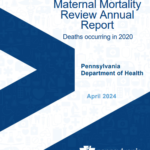
Severe Maternal Morbidity in Pennsylvania, 2016-2022: Individual Level & Regional Factors - April 2024
For every pregnancy, there is a continuum of potential outcomes, from uncomplicated pregnancy, the most common occurrence, to maternal death, the rarest but most severe outcome Severe maternal morbidity (SMM) is defined as the unexpected outcomes of labor and delivery that result in significant short- or long-term consequences to a woman’s health. The goal of this report is to assess trends and identify key contributing factors for SMM in Pennsylvania using Pennsylvania Health Care Cost Containment Council (PHC4) data from 2016 to 2022.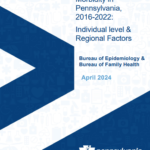
Severe Maternal Morbidity in Pennsylvania, 2016-2022: Individual Level & Regional Factors - April 2024
Severe maternal morbidity (SMM) is the unexpected outcomes of labor and delivery that result in significant short- and/or long-term impacts on a woman's health. SMM can impact physical and mental health, as well as social and financial situations for women, families, and communities. This fact sheet contains key findings from an analysis of trends of SMM and key factors contributing to SMMs among hospital births in Pennsylvania from 2016-2022. Data are from the Pennsylvania Health Care Cost Containment Council (PHC4).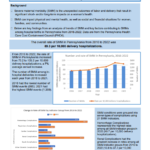
Report: Perinatal Psychiatry Access Program in Pennsylvania - January 2024
Mental health conditions during the perinatal period for women are the most common complications reports, affecting 1 in 5 women during pregnancy and up to one-year postpartum. This report looks at Perinatal Psychiatric Access Programs, a tool that 21 other states have implemented, as an opportunity for Pennsylvania to meet the rising needs of pregnant and postpartum mothers facing mental health challenges.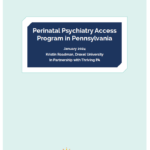
Brief: Are Postpartum Mental Health Resources in Pennsylvania Adequate? - January 2024
This brief highlights the lack of accessible mental health supports for postpartum women across the Commonwealth. The Pennsylvania Health Access Network (PHAN), partnered with Thriving PA to hear directly from birthing individuals, through a statewide survey and 3 focus groups, about their access to necessary mental health services during the first year after giving birth. This report highlights the findings and the need for Pennsylvania to increase more access to mental health care for postpartum individuals.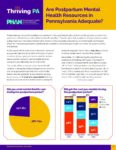
Fact Sheets: Maternal Health - August 2023
Our first-ever maternal health county fact sheets show each county's overall perinatal vulnerability index (PVI). The PVI uses data across five domains: behavioral health, environmental context, health care availability, pregnancy and birth outcomes, and social stratification. The fact sheets also highlight data about prenatal care and the percentage of low birth weight births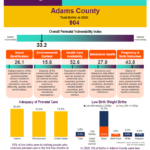
Children’s Health Insurance
Fact Sheets: Medicaid & CHIP Provide Quality Health Insurance for Half of Pennsylvania Kids – February 2024
Over the past year, much has happened in Medicaid and the Children’s Health Insurance Program (CHIP) that has changed how families apply for or renew public health insurance for their children. What hasn’t changed is that Medicaid and CHIP continue to offer comprehensive health coverage, including access to medications, well-child visits, vaccinations, and more for children in every community across the Commonwealth. The three fact sheets in this series show enrollment by Congressional, state House, and state Senate districts.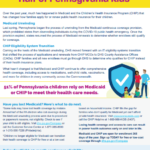
Report: State of Children’s Health in Pennsylvania – November 2023
The 2023 State of Children’s Health report analyzes the latest Census data around children’s health insurance during the last full year of the COVID-19 pandemic public health emergency, and the results are surprising. In what was expected to be another year of improvement thanks in large part to pandemic-era flexibilities in Medicaid and the Children’s Health Insurance Program (CHIP,) the 2022 data instead shows children in Pennsylvania are less connected to health insurance than the prior year.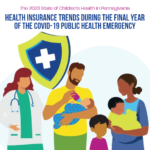
Prenatal and Children’s Nutrition (Women, Infants and Children Program – WIC)
Fact Sheets: Women, Infants and Children (WIC) Program - April 2024
Children need access to nutrition for their growing bodies and minds to be healthy and develop as they should. The Special Supplemental Nutrition Program for Women, Infants, and Children (WIC) is a critical component in ensuring infants and toddlers, as well as pregnant and postpartum mothers, have access to healthy nutrition. See WIC coverage rates statewide and at the county level.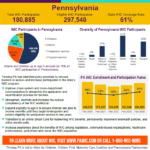
WIC Participants Encourage Improvements to Remove Barriers to Access - December 2022
Thriving PA identified a clear need to increase WIC enrollment and engaged clients to learn what strengths and challenges they experienced with the program and gather suggestions for improvements. These virtual family and community stakeholder focus groups were an opportunity to obtain feedback from program participants and learn what short- and long-term program changes they recommend. More than 50 current and former WIC participants provided insight into the WIC program’s strengths, barriers to participation, and ideas for modernization.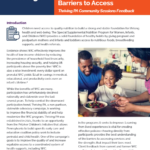
PA WIC Program Data
The PA WIC data reports below represent WIC participation rather than caseload/enrollment. Participation: The number of enrolled women, infants and children within a reporting period who receive benefits. This includes fully breastfed infants and women partially breastfeeding an infant who are not eligible for food benefits. Caseload/Enrollment: The number of individuals who are within a valid certification period and eligible to receive benefits. Note: It is understood local agencies (LA)s may use caseload to mean workload which includes applicants applying for the program but are not enrolled. However, for the purposes of the SA and the reports run in MIS, caseload and enrollment are interchangeable.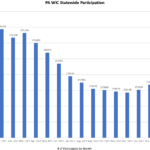
Early Intervention
Support Infant and Toddler Early Intervention in Pennsylvania - March 2025
Infant and Toddler EI is a program that provides services to children from birth to their third birthday who have a developmental delay or a high probability of having a developmental delay. Also referred to as Part C EI, these services aim to improve outcomes that are critical to a family’s ability to support their child’s health, optimal development, educational success, and lifelong well-being.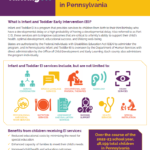
Infant and Toddler Early Intervention: What Initial Data Reveals for Pennsylvania - February 2025
Since 2022, the Early Learning Pennsylvania coalition and the Thriving PA campaign have been proud to increase awareness of and foster policymaker support for Infant and Toddler Early Intervention (EI), also known as Part C EI. With a statewide advocacy workgroup convened for the first time, an initial goal was to receive and analyze EIrelated data from the Office of Child Development and Early Learning (OCDEL). A formal request was submitted to the state in 2023 for both FY 2021-22 and FY 2022-23 Infant and Toddler EI data, and to date, the workgroup has received and analyzed statewide and county-level data specific to the areas of fiscal, eligibility, and enrollment information.
Pediatric Health Care and Infant & Toddler Early Intervention
The majority of referrals to EI come from children’s physicians and health care providers. When parents have questions or concerns about their child’s development, they look to their pediatrician for guidance. Development happens quickly and should be an ongoing conversation between families physicians.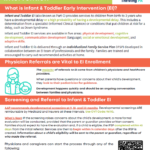
Intervención Temprana
La Intervención Temprana es un programa disponible sin costo, independientemente del ingreso familiar, para bridnar servicios a niño que tienen o están en riesgo de sufrir retrasos en el desarrollo.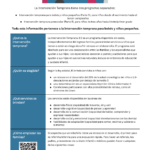
Infant and Toddler Early Intervention Fact Sheet - September 2024
Have questions about Early Intervention specific to infants and toddlers (also known as Part C)? This fact sheet is a great resource for parents, early care and education providers, families and others wanting to learn more about the basics of the program, including services offered, how to connect to the program through a referral, and what to expect on timeframes.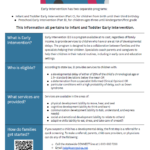
Report: Statewide Advocacy Agenda to Improve Part C Early Intervention Services for Pennsylvania – June 2022
After a year-long planning project co-lead by PPC and the Pennsylvania Association for the Education of Young Children (PennAEYC), this report is a culmination of months of interviews and focus groups with interested stakeholders, a national analysis of early intervention work in other states, and a review of data and current practices in Pennsylvania’s early intervention system.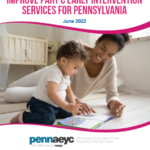
Children’s Lead Screening and Abatement
TOXIC LEAD: PA Lawmakers Must Act to Protect Children
Lead can seriously harm a child’s health and cause well-documented adverse eects such as damage to the brain and nervous system, slowed growth, development and learning and behavior, hearing and speech problems – which can cause lower IQ, decreased ability to pay attention and under-performance in school often requiring special education services. View the fact sheet to learn more.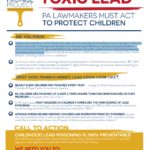
Report: Preventing Childhood Lead Exposure in Pennsylvania – September 2023
This fact sheet highlights an overview of implementing lead remediation practices, and how by investing in children’s health now can prevent Pennsylvania’s children from being exposed to lead and ensure that they are less likely to be involved in the justice system later in life.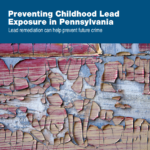
Screening Guide - August 2022
Child Blood Lead Testing and Care Management: Guidelines, Strategies and FAQs for Pennsylvania Primary Care Providers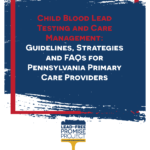
A Resource Guide: Care Management of a Child with Elevated Blood Lead Levels- March 2022
This resource guide reports on what to do in case lead-based paint hazards are in children’s homes, including information on who to contact in case of exposure to lead poisoning.
6 Steps Handout
Using municipal codes and other strategies to protect children from lead paint poisoning and improve property values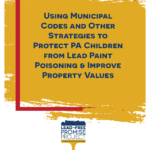
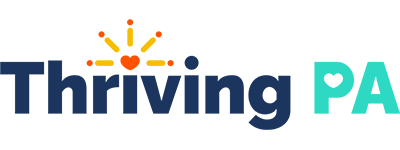

Thriving PA Follow 821 237
We're a non-partisan, statewide campaign with the goal of ensuring each mother and child in PA has the opportunity for affordable, quality health care access.
Are you a healthcare provider? During #BlackMaternalHealthWeek, learn how you can support pregnant women to reduce factors that contribute to pregnancy-related complications and maternal mortality. ↓